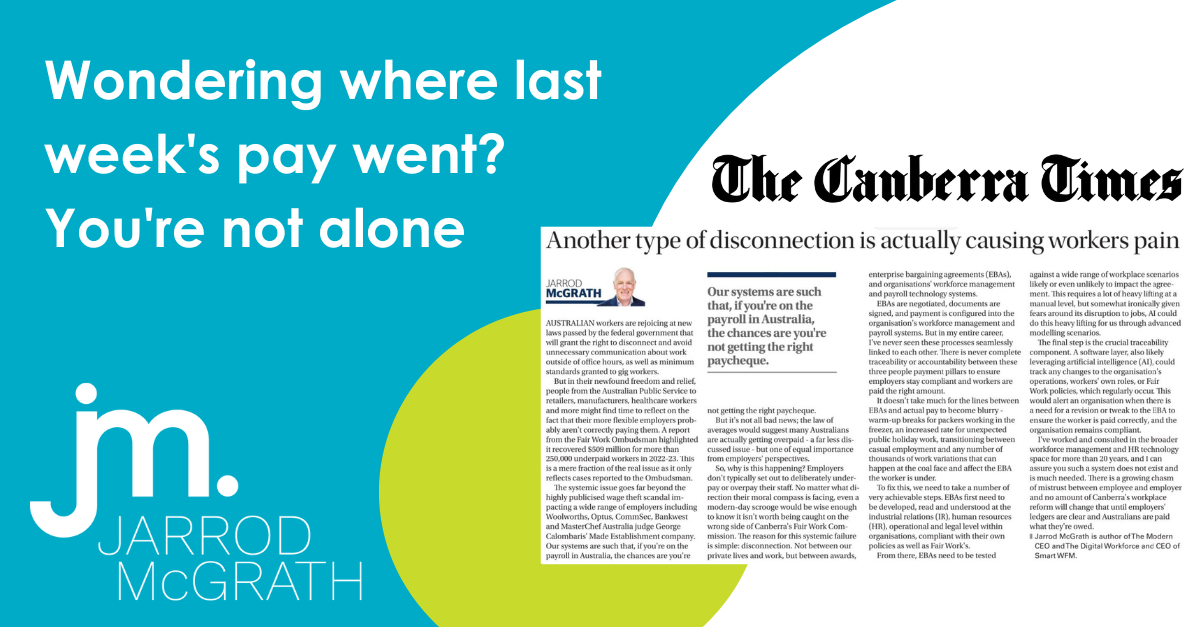Wondering where last week's pay went? You're not alone
I wrote in The Canberra Times about the disconnect between awards, EBAs, and organisations’ workforce management and payroll technology systems.
3 min read
 Jarrod McGrath
:
Nov 12, 2020
Jarrod McGrath
:
Nov 12, 2020

In a thought-provoking piece for The Mandarin, I address the critical issue of the nearly trillion-dollar investment in people by organizations with little understanding of the return on investment (ROI). This commentary highlights the urgent need for more strategic and measurable approaches to managing workforce expenditures. As the business landscape evolves, gauging the true value of these investments becomes essential.
The latest ABS data we have on Australian labour costs takes us all the way back to the 2015-16 financial year, with the next release date unknown – this is fitting for how little we know about how much Australian businesses spend on people, or the return they get from it.
That data showed $760.9 billion was spent on labour, with employee earnings accounting for 87.3% of that. With the overall economic growth in that time, explosion of the sharing economy, a complete shift in how and where people work, and much more, the next numbers are anyone’s guess.
With close to – or potentially even more than – a trillion dollars being spent on people, and multiple trillions globally, we’re forced to wonder what kind of return we’re getting on that investment. Talk to most CEOs and CFOs, and they won’t be able to tell you either.
Sure, plenty of organisations have some kind of formula worked out – many consulting-focused businesses have a ‘you get paid one third of what you bill’ model. Sales reps are often heavily bound to commission, with companies having a safety net of them having to drive sales to get their rewards. But none of these factor in any kind of true return, or loss, on the significant investment being made.
How much am I spending on overtime? Do we really need to complete the overtime for the team’s day-to-day work? What happens if I use a casual rather than paying overtime to complete the work? How much time has that new digital service I introduced saved? What is my team doing with that extra time?
Just scratch the surface and it begs so many questions, but so far there are very few answers, and certainly nothing pulling this information together to give businesses a clear view of cost versus ROI on the costliest resource for virtually all of them.
Determining this ROI is more important than ever – virtually overnight, companies had their workforces taken away from them, reducing their visibility to short windows over video conferencing, or maybe a status update tracker that shows whether staff are (available) or (away).
Workforces are scattered, with remote working now the norm for entire companies. Australian tech darling Atlassian has told staff they can work from wherever they like, forever.
As industry leaders and influential bodies, these moves will impact the overall thinking and approach on workforce and workplace matters. Counter opinions and research elsewhere show that, in all likelihood, we’re heading for a hybrid workplace in Australia, where physically being in the office is optional for many.
This raises the stakes and difficulty in organisations measuring the value of their workforce – we didn’t know the value before; we need to know for the future.
The answer of course is the cause of, and solution to, so many of our modern issues: data.
Like never before, we’ve got the ability to collect, store, analyse and draw value from mammoth data sets. This will improve further with the development of artificial intelligence (AI) and machine learning.
The ability to capture every single element of the ROI on an employee – whether they’re casual, self-employed, part time, compensated through shares, or any other variable you can think of – exists. Yet, there is nothing in the works and no impetus from government or industry to develop it, leaving our people-spend a mystery.
We can see the opportunity cost in more or less any industry. Our healthcare sector is the envy of the world and has stepped up in an incredible way during COVID-19 – but we don’t know the value of it, the cost of training clinicians, the loss when we train them and they take their skills abroad, and how much we should invest into continuing professional development (CPD).
How long will the industry be world-leading if we can’t leverage this kind of data in a data-dominated global economy?
If we can get this right, we can increase value from the shareholder to the coal face. Investors often pressure companies to put jobs on the chopping block to increase shareholder value, often not knowing the value of what they’re cutting or the long-term impact. With data, businesses could show them.
As we look to innovate our way out of this crisis, reinvent industrial relations, and move past the crippling underpayment scandal that has plagued so many organisations, government needs to think bigger and lead the charge on building data and ROI models into what we spend on our most valuable resource.
Jarrod McGrath is author of The Digital Workforce and founder and CEO of Smart WFM
Originally published by The Mandarin
Jarrod McGrath, November 12, 2020

I wrote in The Canberra Times about the disconnect between awards, EBAs, and organisations’ workforce management and payroll technology systems.

Read the intriguing paradox of Australia's tech industry in my article for The Australian Business Review. I explore the surprising decline in...
.jpg)
In my article for The Australian, I discuss the importance of meaningful employee engagement beyond mere formalities. It's a call to action for...